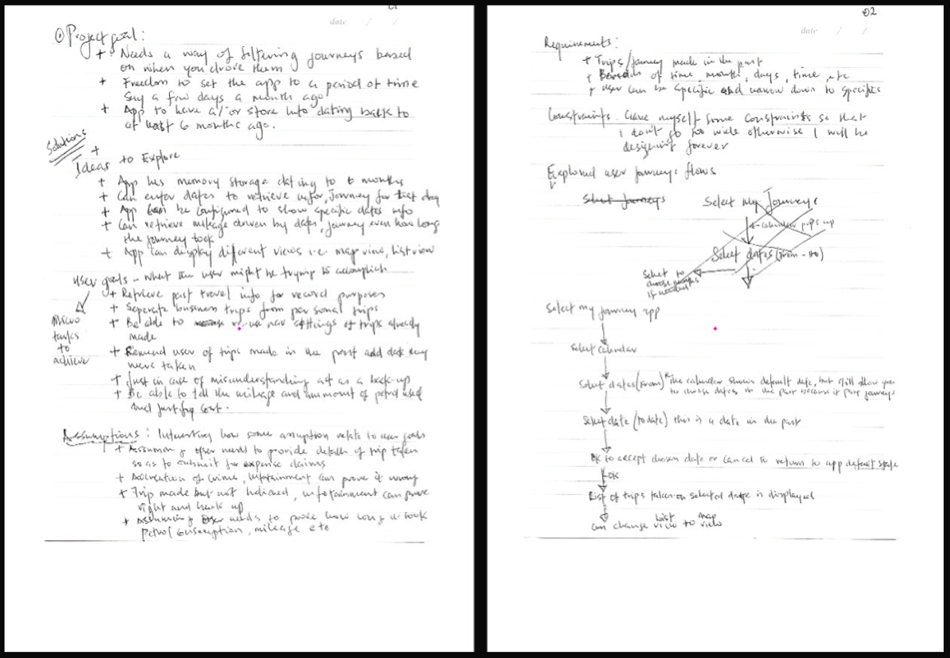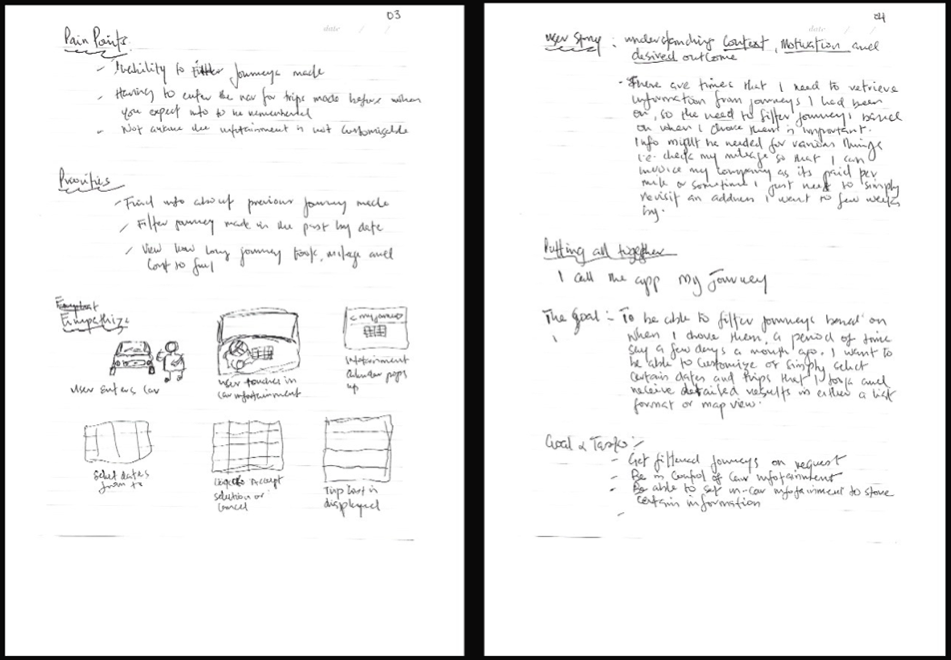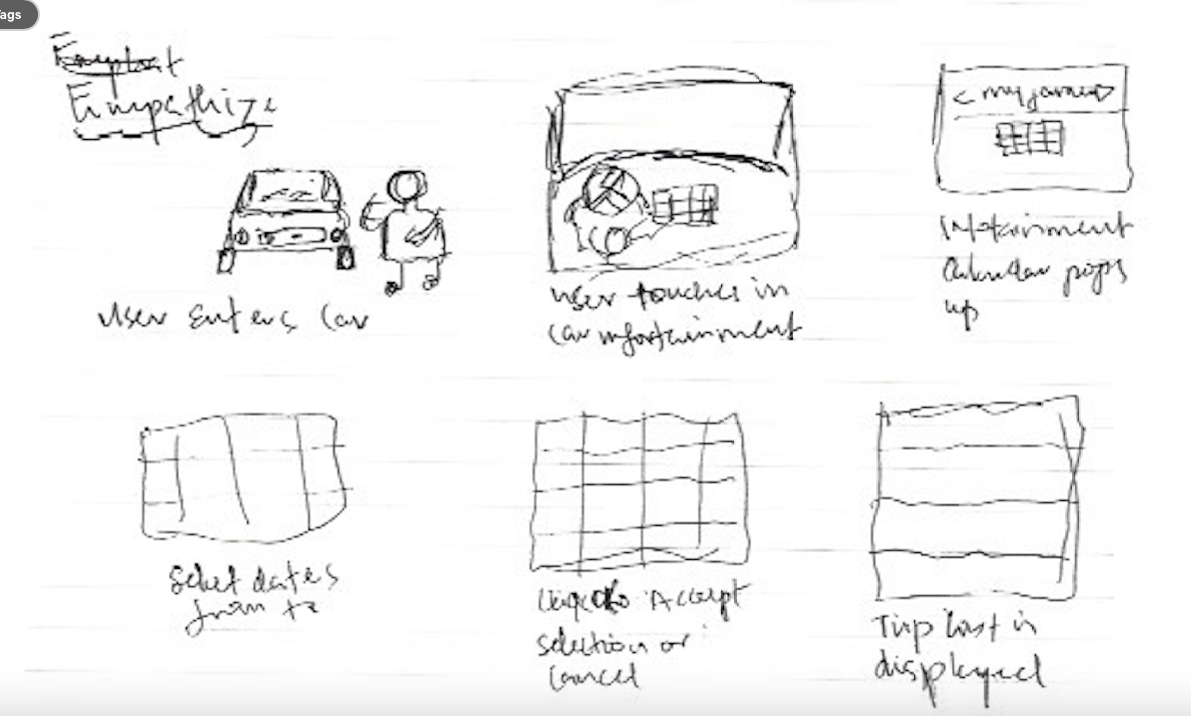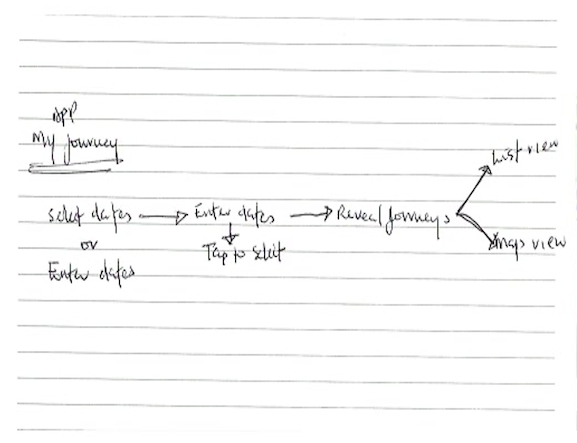
Title: Ford Pass (UX) user experience Design Challenge.
Time: 8hours completion time.
The client presented me with the task of creating a feature to filter car trip journeys based on their date, allowing users to narrow down their search to a specific time frame, such as a few months ago. To address this challenge and enhance the user experience, I devised a process and solution and incorporated it into the "My Journey" section, which you can see the journey and then the wireframes below.
Ford Pass Screenshot.
Processes.
The journey began with the use of a physical notebook to capture and organize my design ideas and thought process. Commencing on paper provided me with the creative freedom to explore various directions without any constraints, enabling me to examine the challenge from multiple angles and approaches. Think of it as taking a helicopter view of the problem.
Presented below are my sequential notes, moving from page to page numbered 1 through 4:
I initiated the process with preliminary project goal ideas.
Next, I sketched out potential solution concepts for exploration.
I then delved into user goals, breaking them down into micro-tasks.
Fascinating assumptions emerged, revealing connections to user goals.
This paved the way for defining user requirements and constraints.
User journey flows were outlined, with the scribbles to be disregarded. Focus on the clarified flows beyond the scribbles.
On the third page, I uncovered user pain points and their priorities. My Picasso-inspired drawings demonstrate my empathy for the user's perspective.
Finally, on the fourth page, I crafted comprehensive user stories, diving into context, motivations, and the desired outcomes.
The Goal.
Create a user-friendly solution for Peter to efficiently filter and access his historical journey data from his in-car infotainment system. The goal is to enable him to retrieve information such as journey duration, mileage, date, and fuel expenses, facilitating his quarterly expense reporting to the company. The system should also provide a clear distinction between his business-related trips and personal ones for accurate expense claims.
User Goals:
Easily access filtered journey information on demand.
Customize the view of their past journeys to meet their specific preferences.
Seamlessly differentiate between business and personal trips.
Retrieve detailed trip data including miles driven, duration, date, time, and fuel cost.
User Tasks:
Initiate a search for filtered journeys using the in-car infotainment system.
Retrieve and review past journeys made, spanning up to six months in the past, using the infotainment system.
Navigate and interact with the in-car infotainment as if it were a comprehensive diary of their past journeys.
The Process.
Part 1
In this phase, i thoroughly understand the user (Peter) by creating user stories and defining his journey. This process helps me identify and articulate the specific requirements for the app.
Understanding Peter's User Persona.
When Peter gets into his car, he embodies the following characteristics and expectations:
Eager to commence the day's activities.
Prepared to input planned journey details for the day.
Excited about fulfilling scheduled appointments.
Highly conscious of time management.
Technologically adept and tech-savvy.
Reliant on the in-car infotainment system to retain journey information.
Understanding Peter's User Priorities, his primary concerns and needs are as follows:
Priorities:
The ability to easily access and retrieve his historical trips.
A streamlined method for filtering journeys based on when they occurred.
A straightforward and efficient way to filter past trips.
Quick and accessible guidance for retrieving stored data.
Pain Points:
Difficulty in navigating through the in-car infotainment system to filter journeys.
Lack of contextual help or guidance for retrieving information.
Wasting time while trying to access stored data in the car.
Resorting to manual note-taking due to infotainment storage limitations.
Inability to filter journeys as desired due to system constraints.
Feeling lost and frustrated when attempting to use the infotainment to retrieve saved appointment roadmap.
User Story: Streamlining Expense Reporting.
In the context of using my in-car infotainment system, I aim to efficiently filter and access my past journeys based on their dates, ensuring that I can effortlessly compile the necessary information for my expense report submission.
When I compile my expense report, my primary goal is to ensure that it encompasses all the intricate details of my business trips, Including specifics such as the client visited, the duration in both minutes and hours, the mileage covered, fuel costs incurred, and the exact date and month of each trip. This meticulous record-keeping is crucial to ensure that my invoices are processed and paid promptly.
Peter's In-Car Infotainment Interaction
Before, during, and after engaging with the in-car infotainment system, Peter follows these steps:
Peter enters his car.
He fastens his seat belt and starts the car.
On the car's infotainment screen, he taps the calendar icon.
The calendar defaults to the current date/month; therefore, he taps the month icon to select the previous month, which is the one he needs to retrieve information from.
He notices the pencil icon at the top right-hand corner of the screen, allowing him to change the view from list to map view.
To select a date range, he taps to select the "from" date and then taps again to select the "to" date.
He confirms the date range selection by tapping the "OK" button at the bottom of the calendar.
The in-car infotainment system displays a detailed list of journeys for the selected date range.
Peter observes that the days between the chosen start and end dates are also grayed out, indicating the selected period.
In the top right-hand corner, there is an "X" icon that he can use to exit the screen and return to the default state.
Peter proceeds to complete his invoice using the information displayed on the list, exits the infotainment screen, and drives to the office to submit his invoice.
Drawings below capture a glimpse into my creative process and approach when tackling various challenges. In some instances, I opt for sketching and drawing to convey ideas, as showcased here, even though my drawing skills may not be considered exceptional. They serve as a reflection of my commitment to exploring different methods and my willingness to embrace imperfections in pursuit of innovative solutions.
The Process.
Part 2
This section outlines the key assumptions, requirements, constraints, and the eventual trade-offs that informed the decision-making process."
App Objectives:
Reliability:
Ensure consistent and dependable performance.
Enhance user engagement by delivering a seamless experience.
Provide accurate and reliable data and information.
Maintain transparency by detailing Peter's journeys comprehensively.
Improve discoverability of new features.
Usability:
Prioritize user intent and goals, minimizing complexity.
Deliver a straightforward, distraction-free experience.
Enable quick and efficient navigation from point A to B.
Offer timely and informative content, avoiding confusion and extraneous information.
Assumptions:
The in-car infotainment center possesses ample storage and memory capacity for efficient data storage and retrieval.
In the event of an institution or accident, a USB memory stick is available for data storage.
Data can be either deleted or transferred to another vehicle if necessary.
A reliable network connection, facilitated by a connected mobile phone, enables the emailing or sending of filtered journeys.
The in-car infotainment system can retain historical data for up to six months.
Password protection is implemented to confirm requests for displaying journeys or deleting the database.
Constraints:
To maintain a linear flow and achieve defined objectives, the following constraints have been established:
Future journeys cannot be filtered within the app.
Calendar functionality permits selection of dates only in the past.
Trips made cannot be deleted or retrieved without the use of a confirmation password.
Journey filtering is disabled while the vehicle is in motion and is only available when the vehicle is stationary.
Trade-offs:
In the real-world scenario, the design and development of this app could span several months. To streamline the user experience, I consciously made specific trade-offs. These decisions were made with a clear understanding of the implications, and I aimed to ensure that the app remains user-focused and goal-oriented.
Exclusion of Future Journey Filtering:
Priority on Filtering Past Journeys: The user's primary objective is to filter journeys based on when they were driven. Therefore, I prioritized this functionality to make it efficient and straightforward.
Minimal User Barriers: The app is designed to be user-friendly without requiring users to create an account or log in. Users can interact with the system as soon as it launches, ensuring a seamless experience.
Assumption of Minimal Profile Usage: Given the user's needs, there was no requirement to create accounts with login details, keeping the process simple and accessible.
Alert Notifications:
Potential for Storage Alerts: While alert notifications for storage capacity could be valuable, due to time constraints, this feature was not explored in-depth. It wasn't deemed necessary for users to achieve their primary goal."
These trade-offs were made to streamline the user experience and prioritize the core functionality of the app. Each decision was made with the user's needs and objectives in mind, ensuring a straightforward and efficient interaction.
App Flow (1)
The design flow on the left illustrates how users navigate through the app to accomplish their goals.
Upon reviewing the flow, certain unnecessary steps have been identified and crossed out to align with the previously mentioned requirements.
Many of these steps initially required user opt-in.
Instead, I proceeded with the assumption that users would prefer to opt into these elements as they are relevant to achieving their goals.
App Flow (2)
The refined flow eliminates unnecessary and additional steps, focusing instead on a streamlined A-B experience.
The user is presented with a screen that enables the selection of dates or manual entry to view journeys based on when they were driven.
After reviewing past journeys, the user can select a specific journey to access detailed information, including miles driven, time, fuel cost, and the trip date.
Users have the flexibility to switch between map and list views, and importantly, they can take notes and record essential information, especially for expense tracking.
Wireframes.
Taking into consideration Peter's primary objectives:
Customize and access journeys based on my filters.
Access detailed trip data (miles driven, duration, date, time, and fuel cost).
Change the view of past journeys.
I created wireframes that align with these objectives in the following manner: For instance,
The calendar icon provides a clear method to filter past journeys by the dates they were driven, streamlining the results to achieve these goals in a single interaction.
These additional design elements ensure that the initial goal (Goal 1) is accomplished without any unnecessary distractions.
Below, you'll find my low-fidelity wireframes intentionally kept free from excessive visual design or UI elements. Instead, they focus on problem-solving and showcasing my ability to design a product and user experience.
The user's journey begins with a tap on the calendar icon next to 'Select Dates.' Here, they can either manually type in the dates or select them sequentially. The option to navigate back in time and choose past months' dates is represented by the pencil icon at the top right. Once the desired dates are selected, the user's request is fulfilled.
Now, they can explore their filtered journey history from the past. They have the choice of viewing these filtered selections in two ways: a map view or a list view. Both views provide essential information, including miles driven, trip duration, fuel cost, and the date and time of each journey.












